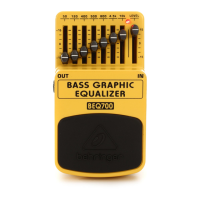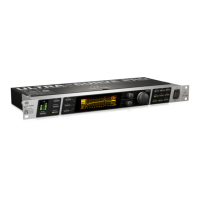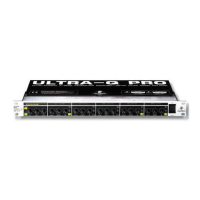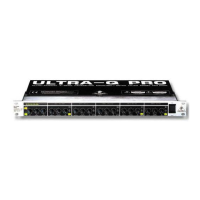9 FEEDBACK DESTROYER FBQ1000 User Manual
The three remaining lters (all set to Auto mode “AU”, see chapter 6.3) areused
to detect and suppress new feedback frequencies, which can be produced,
e.g.when the singer moves around the stage with the vocal mic in his/her hand.
Since the FBQ1000 can by no means “know” whether or not the risk of feedback
has been eliminated (e.g. when the singer moves to another position), the rst
AU lter of the unit locks to the detected frequency, while the remaining two
AU lters are used to suppress any new trouble frequencies that may occur.
Only when all AU lters have been used, will the rst AU lter used (here: 10)
beunlocked, so as to be able to detect new feedback frequencies.
Basically, all active lters (both in “AU” or “SI” mode) are represented by ashing
LEDs in the STATUS INDICATOR (2). When feedback has been detected and is
being suppressed, the associated lter LED lights up constantly. Filters set to
Parametric EQ mode (see chapter 6.2) also have constantly lit LEDs.
◊ Please read the detailed description of all operating modes (chapter 6)!
5.1 “Priming” the FBQ1000 for P.A.
and monitor applications
With the FBQ1000 you can improve the protection against feedback even before
the show begins, by “tuning in” your sound reinforcement system. We already
dealt with this in chapter 3. But now it’s not about using a preset, but about
how to determine in which modes the lters are used: Set some of the lters to
Single-Shot mode (see (7)).
First, let’s take a look at the monitor path: Open all microphone channels, turnup
the Aux Send controls on all channels you wish to route to the monitor mix,
then slowly move up the monitor master faders. For the front mix do as follows:
Slowly move up the channel and master faders. In both cases, the rst feedback
frequencies can be heard after some time.
Without the FEEDBACK DESTROYER you could not increase the volume level of
your system any further. With the FBQ1000, however, you can considerably
enhance the system headroom! Let the Single-Shot lters on the FBQ1000
suppress feedback as it occurs. Then cut back the volume to the level required
for the show. In this way, you can be sure that there is enough system headroom
should it become necessary to raise the volume level during the concert.
Experience has shown that musicians want to have the volume of their
instrument increased on the monitor as the concert goes on. With the FEEDBACK
DESTROYER you can turn up the volume without having to fear feedback
problems. When the show begins you should set several lters to Auto mode,
in order to suppress feedback produced by “moving” (vocal) microphones.
Moreinformation on Auto mode can be found in chapters 5 and 6.3.
6. Operating Modes of the FBQ1000
The individual lters on the BEHRINGER FEEDBACK DESTROYER can operate in
four dierent modes (see (7)). An additional mode called “Locked” mode will be
described specically. Basically, each of the 2 x 12 lters on the FBQ1000
can be set to any of the four operating modes. To meet more complex
requirements with regard to exible signal processing, these modes can be
combined in a program and stored in a preset.
6.1 O mode “OF”
In O mode, the corresponding lter is deactivated and can be activated by
selecting one of the modes described below.
6.2 Manual lters (“PA”) / Parametric equalizer
To raise or lower specic frequencies in level, you can select these frequencies
directly by setting the manual lters to Parametric EQ mode. Each lter has
the functionality of a fully parametric EQ, i.e. you can set the center frequency
(FREQUENCY key (10)), the bandwidth (BANDWIDTH key (12)) and the amount of
boost/cut (in dB) using the GAIN key (13).
6.3 Automatic lters (“SI” and “AU”)
Automatic lters operate in two modes: Single-Shot (SI) and Auto mode (AU).
In order to nd a feedback frequency, the FEEDBACK DESTROYER divides the
entire frequency band into 1/60 octave steps (20 Hz to 20 kHz) and determines
the respective level of these individual bands. The unit then compares this value
to the level of the entire signal. The dierence between these levels determines
whether a lter is set or not. The FEEDBACK DESTROYER gives you the unique
possibility of adapting this parameter according to your own needs. You can edit
the feedback sensitivity (i.e. the dierence value) within a range from -3 to -9dB,
in 1-dB steps: Simultaneously press the FILTER MODE and GAIN keys, then use
the JOG WHEEL to select a value. The standard value for this parameter is -6 dB,
which provides for an optimum detection of feedback in most applications.
Example: During a pure speech transmission, the feedback sensitivity can be
lowered to -9 dB. In this way, the algorithm would recognize and suppress
feedback even faster. On the other hand, a higher setting, e.g. -3 dB, allows you
to leave those signals unaected which you don’t want to suppress (e.g. guitar or
keyboard signals).
Filters in Single-Shot mode automatically analyze the music signal to detect
feedback frequencies. Having detected such a frequency, the lter automatically
congures its parameters to suppress feedback as eciently as possible. As the
lter is locked to the detected frequency, this mode is ideally suited to suppress
feedback of constant frequency. Possible applications are “xed-position”
microphones (e.g. on the drums). After the lter has adjusted itself automatically,
it enters a special Locked mode (see chapter 6.4), which means that although the
frequency remains xed, the width and depth of the lter are still being adapted
to the feedback frequency, i.e. the width is increased as soon as the feedback
frequency begins to shift, and the gain is cut if feedback prevails. The gain is not
reduced to prevent feedback from recurring.
All microphones that are moved during a performance (e.g. vocal mics)
veryoften have varying feedback frequencies. This type of feedback should be
suppressed in Auto mode. As in Single-Shot mode, the lter automatically
selects an ideal setting for feedback suppression. However, in Auto mode the
rst AU lter set is unlocked to suppress new feedback. The optimum frequency
is selected automatically and the lter is set to narrow-band mode, so as to
inuence the music signal as little as possible. If your music contains wanted
feedback elements (e.g. guitar feedback), it is highly probable that these will be
suppressed too in Auto mode, because it is impossible from a physical point of
view to distinguish “wanted” from “unwanted” feedback. Please read chapter 2.3
to nd some information on how to work around this situation.
6.4 Locked mode (“LO”)
When the FBQ1000 detects a feedback frequency in Single-Shot mode
(seechapter 6.3), it automatically enters Locked mode, i.e. the lter locks to the
trouble frequency and “keeps an eye” on it. To unlock such a lter, you need to
switch it back to Single-Shot mode (see (7) and chapter 7.2).
7. Working with Presets
In order to store your favorite settings, the FBQ1000 has ten user presets and one
default preset. All operating parameters can be stored, so that your programs
are recalled in full detail. Owing to state-of-the-art circuitry, no internal battery
is needed, hence the memory contents will not get lost. In the default preset
(Display: “--”), which serves as a starting point for your own programs, all lters
remain in Parametric EQ mode, with bandwidth set to 1 octave, frequency to
500 Hz and 0 dB gain.

